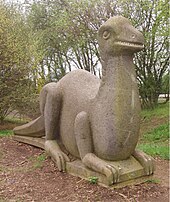Geo-garden angels
The Engeln Geogarten is part of the Brohltal / Laacher See volcano park at Engeln train station in the Eastern Eifel .
The geo-garden was established in 1998 and has an area of around 1000 m². At several stations to the right and left of the track system in front of the terminus of the tourist museum railway Brohltalbahn , knowledge of geological history is imparted more playfully. The establishment of the park was scientifically supervised by the Bonn geology professor Wilhelm Meyer . The circular route is primarily intended for families with children. It is freely accessible, but only partially barrier-free . The geogarden can also be reached via the Eifelleiter hiking trail or integrated into this tour. In addition, a signposted “round tour” of around 13 km around Engelen train station to Kempenich with its “Steinrausch Adventure Forest” is possible.
Stations
The circular route begins on the station side with the Devonian Gate and the Devonian Sea at station 1 and 2. In the Devonian era about 350 million years ago, the area around Engeln was covered by a shallow sea, from which a mountain range of folds later developed.
Station 3 shows a scaled-down replica of an iguanodon . As also z. B. the Eifelosaurus , this animal, which could be nine meters long, is proven for the Mesozoic in the Eifel . The dinosaurs lived in this area until about 65 million years ago.
About 50 million years ago, in the Tertiary , the first volcanoes became active in the Eifel. The replica of a giant frog as it once lived in the Kunkskopfsee near Burgbrohl marks this stage of the development at station 4. The Tertiary began about 65 million years ago and ended two million years ago.
The other stations of the Engeln geo-garden are beyond the tracks. The first rock carvings of Stone Age people were made around 70,000 years ago . Such a cave painting is reproduced at station 5.
At station 6 there is a replica of a volcano, which indicates the special importance of volcanism, especially the eruption of the Laacher See volcano 13,000 years ago, for the design of the landscape around the Laacher See. More than 30 volcanoes were active in the Eifel until about 11,000 years ago.
A Celtic stone circle at station 7 and a Roman archway at station 8 indicate the first inhabitants of the area who deliberately mined stones. Trass , tuff and basalt are used in numerous Celtic and Roman structures in the Eifel.
Tuff was a popular material, especially in church building and with sculptors, because it was easy to work with. Evidence of the use of this stone comes from the Middle Ages , the Renaissance , the Baroque and also modern times . Station 9, a small maze with various figures, indicates this use of the tuff.
Web links
Individual evidence
Coordinates: 50 ° 25 ′ 30.9 ″ N , 7 ° 9 ′ 24 ″ E


